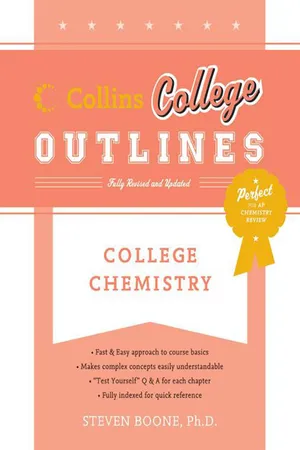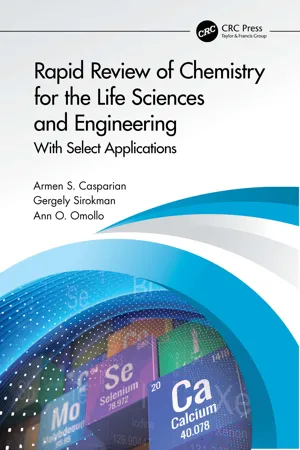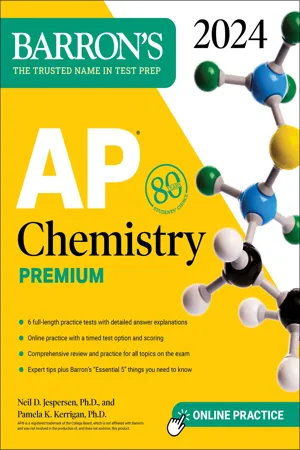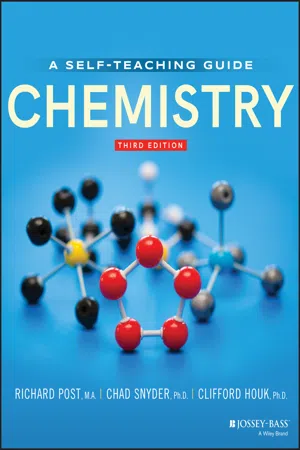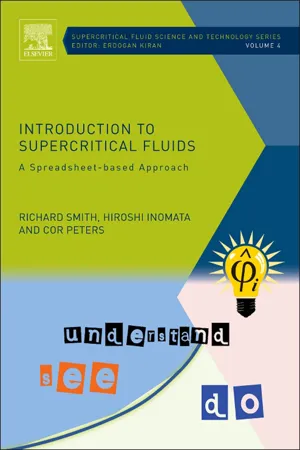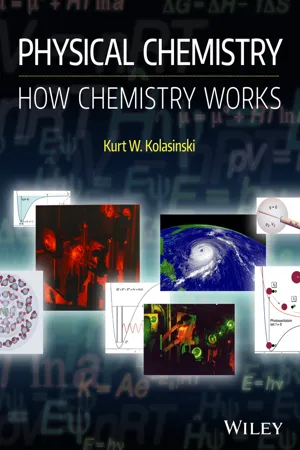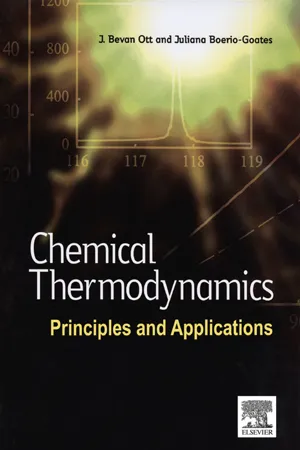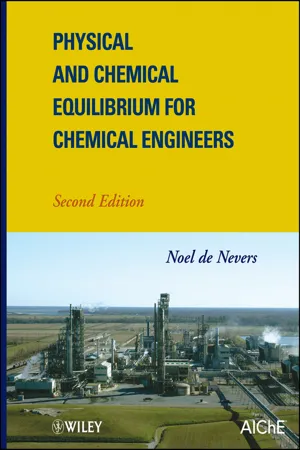Chemistry
Chemical Equilibrium
Chemical equilibrium is a state in a chemical reaction where the forward and reverse reactions occur at the same rate, resulting in no net change in the concentrations of reactants and products. At equilibrium, the concentrations of reactants and products remain constant, but the reactions continue to occur. This dynamic balance is described by the equilibrium constant.
Written by Perlego with AI-assistance
Related key terms
Related key terms
1 of 4
Related key terms
1 of 3
10 Key excerpts on "Chemical Equilibrium"
- No longer available |Learn more
- Steven Boone, Drew H. Wolfe(Authors)
- 2011(Publication Date)
- Collins Reference(Publisher)
CHAPTER 15Introduction to Chemical Equilibria
Chemical Equilibrium systems are more resistant to change than those that are not in equilibrium. When an equilibrium system is disturbed, it responds in order to reestablish a state of equilibrium.15.1 THE EQUILIBRIUM STATEChemical reactions proceed spontaneously until they reach a state of dynamic equilibrium. At equilibrium, the rate of the forward reaction equals the rate of the reverse reaction. At this point, the reactant and product concentrations remain constant.Forward and Reverse ReactionsArrows that point in opposite directions, , show that an equilibrium has established. For example, the following equation is written for the equilibrium of H2 and CO2 with CO and H2 O.H2 (g) + CO2 (g) CO(g) + H2 O(g)The reaction that goes from left to right is the forward reaction, and the reaction that goes from right to left is the reverse reaction. Establishing Equilibrium Consider the following model reaction as it establishes equilibrium.H2 (g) + CO2 (g) → CO(g) + H2 O(g)When H2 and CO2 mix at constant temperature in a reaction vessel, they combine and begin to form the products, CO and H2 O. Hence, the concentrations of H2 and CO2 decrease, and the concentrations of CO and H2 O increase. As the reactant concentrations decrease, the rate of the forward reaction decreases and the rate of the reverse reaction increases. At some point, the rate of the forward reaction equals the rate of the reverse reaction and a Chemical Equilibrium establishes. After this time, the concentrations of the reactants and products do not change.The Equilibrium Constant ExpressionAn important quantitative relationship exists between the concentrations of the reactants and products. This relationship was identified by Cato Maxmilian Guldberg and Peter Waage in 1864 when they proposed the Law of Mass Action that expresses the equilibrium concentrations of the reactants and products in terms of an equilibrium constant expression (equilibrium expression - eBook - ePub
- Jeffrey Gaffney, Nancy Marley(Authors)
- 2017(Publication Date)
- Elsevier(Publisher)
Chapter 7Chemical Equilibrium
Abstract
This chapter reviews the principles of Chemical Equilibrium beginning with the concept that many chemical reactions are reversible. These reversible reactions achieve a dynamic equilibrium where the rate of the forward reaction equals the rate of the reverse reaction. This dynamic equilibrium is described by an equilibrium constant, which is determined from the concentrations of the reactants and products at equilibrium. The magnitude of the equilibrium constant is presented as measure of the extent that the forward and reverse reactions take place. Le Chatelier's principle is introduced and the changes in reaction conditions that can disturb a Chemical Equilibrium are reviewed. The response of the chemical reaction to these changes in reaction conditions is explained in detail. The reaction quotient is presented as a means of determining the direction the reaction is likely to proceed.Keywords
Reversible reactions; Dynamic equilibrium; Equilibrium constant; Partial pressures; Le Chatelier's principle; Exothermic; Endothermic; Reaction quotientOutline7.1Reversible Reactions7.2The Equilibrium Constant7.3Relationships Between Equilibrium Constants7.4Le Chatelier's Principle: Disturbing a Chemical Equilibrium7.5The Reaction QuotientImportant TermsStudy QuestionsProblems7.1 Reversible Reactions
The idea that a chemical reaction can be reversible was introduced by Claude Louis Berthollet in 1803 when he observed the formation of sodium carbonate crystals at the edge of a limestone salt lake in Egypt (Fig. 7.1 ). Since the salt lake was a landlocked body of water with a very high concentration of dissolved sodium chloride (> 3 g/L) and other minerals, he knew that the formation of these crystals must be a result of the following chemical reaction;Fig. 7.1 - eBook - ePub
Rapid Review of Chemistry for the Life Sciences and Engineering
With Select Applications
- Armen S. Casparian, Gergely Sirokman, Ann Omollo(Authors)
- 2021(Publication Date)
- CRC Press(Publisher)
4 Chemical EquilibriumDOI: 10.1201/9781003092759-44.1 Basic Concept
Reaction equations describe substances, called reactants, which when put together react and produce other different substances, called products. It may appear as if only products remain after the reaction is finished. In reality, many reactions do not go to completion, even if the reactants are present in stoichiometric ratios or amounts. Rather, they reach a condition known as equilibrium, denoted by double, reversible arrows in the reaction equation. Equilibrium means that there is a balance between the reactant side and the product side, or simply between the reactants and the products, and that the reaction is reversible. The chemistry of many air pollutants falls and many bodily functions under the heading of equilibrium reactions. The equilibrium condition is dynamic, not static, allowing microscopic changes in reactant and product concentrations to take place, such that no net change in reactant or product concentrations occurs, provided that no external stresses are applied. At any given time, all species in the reaction equation—reactants and products—are present at equilibrium in varying amounts. The relationship among these varying amounts can be described by a mathematical formula known as the equilibrium constant expression or simply the equilibrium expression. The equilibrium expression is set equal to an equilibrium constant symbolized by Kc .An equilibrium reaction can be generally represented as follows:a A + b B ⇋ g G + h H(4.1)The Kc expression can then be expressed as follows:(4.2)K c=[ G ]g[ H ]h[ A ]a[ B ]bwhere a, b, g, and h represent the stoichiometric coefficients in the balanced reaction, and the brackets [ ] indicate molar concentrations. The simplest interpretation of Kc is that it is a measure of the extent to which a reaction goes toward completion, i.e., a reaction where the product side is favored. The meaning of Kc - No longer available |Learn more
- Neil D. Jespersen, Pamela Kerrigan(Authors)
- 2023(Publication Date)
- Barrons Educational Services(Publisher)
PART 4Physical Chemistry
Passage contains an image
9
Chemical Equilibrium
Learning Objectives
In this chapter, you will learn:➔Chemical Equilibrium ➔Dynamic equilibrium ➔Equilibrium expression ➔Law of mass action ➔Equilibrium constant➔Kc , kp , ka , kb , ks p , kf➔Manipulating the equilibrium expression ➔Thermodynamically favorable reactions ➔Extent of reaction➔Reaction quotient, Q➔Equilibrium calculations➔Determination of K➔Solubility product ➔Le Châtelier’s principleThe concept of a dynamic equilibrium is central to many aspects of chemistry. In a dynamic equilibrium, chemicals are reacting rapidly at the molecular scale, while their concentrations remain constant on the macroscopic scale.Figure 9.1 shows that a chemical reaction has two well-defined regions in time, and these regions are studied and measured in very different ways. When compounds are first mixed in a chemical reaction, they interact to form other compounds. During the reaction process, the concentrations of the reactants decrease and the concentrations of the products increase. While the concentrations are changing, the reaction is studied using the principles of chemical kinetics, which are reviewed in Chapter 10 . At some point in time, the concentrations of the reactants and products stop changing. Although reactions do not stop at the molecular level, at the macroscopic level the concentrations of compounds in a dynamic equilibrium remain constant. At this point, the compounds are in a dynamic Chemical Equilibrium with each other, and they are studied and described using the concepts of Chemical Equilibrium.Figure 9.1 - eBook - ePub
Chemistry
With Inorganic Qualitative Analysis
- Therald Moeller(Author)
- 2012(Publication Date)
- Academic Press(Publisher)
16Chemical Equilibrium
Publisher Summary
This chapter describes equilibrium constant expressions and explains how to formulate them. It discusses the influence on equilibrium of temperature, pressure, and concentration. The chapter presents a general method for solving equilibrium constant problems. Equilibrium reactions are important in most areas of chemistry, and the chapter describes calculations based on them. Any reversible chemical reaction can achieve equilibrium. An initial mixture of reactants of any concentrations reaches equilibrium, such that the concentrations of reactants and products are related by the law of Chemical Equilibrium. The chapter explains LeChatelier’s principle and the comparison of variations in equilibrium constants, rate constants, and rates. Mixtures of all kinds of substances, such as biochemical fluids, inorganic salts, organic compounds, and polymers, can be separated by the various types of chromatography. The purpose of the separation might simply be to find out how many substances are in a mixture. The equilibrium constant for the distribution of a solute between the two immiscible solvents is called “distribution coefficient.” The chapter illustrates Haber process for the manufacture of ammonia.In this chapter we introduce equilibrium constant expressions and show how to formulate them. The influence on equilibrium of temperature, pressure, and concentration are examined. The last section presents a general method for solving equilibrium constant problems. Equilibrium reactions are important in most areas of chemistry and calculations based on them will reappear in the chapter on acids and bases (Chapter 17 ), in the chapter on ions in aqueous solutions (Chapter 18 ), in the chapter on complex ions (Chapter 28 ), and in the chapters on qualitative analysis (Chapters 22 , 30 , 31 ).Picture a large chicken house divided into two parts by a chicken-wire wall. On one side live 200 white chickens. On the other side live 200 brown chickens. What would happen if someone left the connecting door open? Gradually the brown and white chickens would mix together as their random paths took them through the door. How fast this happens—the “reaction rate”—would depend upon how fast the chickens are moving. The process might be quicker in the morning than just before sundown when the chickens are drowsy - eBook - ePub
Chemistry
Concepts and Problems, A Self-Teaching Guide
- Richard Post, Chad Snyder, Clifford C. Houk(Authors)
- 2020(Publication Date)
- Jossey-Bass(Publisher)
12 Chemical EquilibriumYou have just learned several properties of solutions (mixtures of solids, liquids, and gases). We have discussed reactions that go to completion (reactants totally consumed, leaving only new products) in Chapter 5 and electrolytes that dissociate completely in water in Chapter 11 . Both of these concepts imply a one-way reaction, continuous movement toward the product side. However, in Chapter 10 we discussed a dynamic equilibrium where the rate of evaporation equals the rate of condensation, that is, the reactions are “reversible.”Many chemical reactions are reversible. The products formed react to give back the original reactants, even as the reactants are forming more products. After some time, both the forward and reverse reactions will be going on at the same rate. When this occurs, the reaction is said to have reached equilibrium. There is no further change in the amount of any reactant or product, though both reactions still go on (forever). Since there are many such reactions that appear to go only partway to completion, their study is of major importance to the chemist.We will discuss several types of equilibrium in this chapter, along with their associated problems and concepts. You will use the concept of molarity you just learned in Chapter 11 - eBook - ePub
Introduction to Supercritical Fluids
A Spreadsheet-based Approach
- Richard Smith, Hiroshi Inomata, Cor Peters(Authors)
- 2013(Publication Date)
- Elsevier Science(Publisher)
Chapter 9Chemical Equilibria and Reaction Kinetics
Richard Smith, Cor Peters and Hiroshi Inomata Logic will get you from A to B. Imagination will take you everywhere. Albert Einstein (1879–1955)Tip Box#1 Chapter objectives(1) to review key concepts in thermochemistry (2) to introduce methods for analyzing chemical equilibria (3) to show the effect of nonidealities on “real world” chemical equilibria (4) to introduce thermodynamic analysis of chemical reactors (5) to show how reaction kinetics are used to model reaction pathways9.1 Overview
Chemical equilibria gives one the composition of a reaction system in its most stable state, whereas reaction kinetics gives one the rate at which the chemical species are transformed from their initial state to a final state. Analysis of chemical equilibria helps one to understand the limits of a reaction according to its thermodynamics and the given reaction conditions. Analysis of reaction kinetics helps one to understand how long it will take to make the transformation in reality. Detailed development of chemical equilibria theory is given in many excellent undergraduate textbooks in chemical thermodynamics [CT1 –CT3] and chemical reactions [CT4] .With any type of chemical reaction or process, energy transfer occurs and this is the basis of thermochemistry. The energy transfer of a reaction is described by thermochemical equations, which are balanced stoichiometric equations for the reactant and product chemical compounds. Thermochemical equations are written in terms of the moles of each chemical compound, for example:(9.1)The a and b are stoichiometric coefficients that represent the moles of reactant chemical compounds A and B , respectively, required to form c moles of product chemical compound C . When changes in properties are calculated by treating Eq. (9.1) as a mathematical equation, by convention, the stoichiometric coefficients are positive (+) for products and negative (−) for reactants . Thus, the change in enthalpy of Eq. (9.1) - eBook - ePub
Physical Chemistry
How Chemistry Works
- Kurt W. Kolasinski(Author)
- 2016(Publication Date)
- Wiley(Publisher)
CHAPTER 11 Chemical EquilibriumPREVIEW OF IMPORTANT CONCEPTS
- Any system held at constant temperature and constant volume will evolve until its Helmholtz energy is a minimum.
- Any system held at constant temperature and constant pressure will evolve until its Gibbs energy is a minimum.
- The Gibbs energy change is directly related to enthalpy and entropy changes by Δr G = Δr H − TΔr S.
- The standard Gibbs energy of reaction is related to the equilibrium constant by Δr G°m = −RTln K.
- Both the Gibbs energy change and the equilibrium constant are inherently temperature-dependent.
- The chemical potential of a pure substance is its molar Gibbs energy.
- At equilibrium the chemical potential is the same everywhere in a container for all species in the container.
- A system at equilibrium, when subjected to a disturbance, responds in a way that tends to minimize the effect of the disturbance.
- All ionic solids are assumed to be fully dissociated at infinite dilution but precipitate at the point at which the chemical potential of the solid is lower than that of the solvated ions. This point is when the reaction quotient exceeds the solubility product.
As stated by the IUPAC, equilibrium is the state of a system in which the macroscopic properties of each phase of the system become uniform and independent of time. If the temperature is uniform throughout the system, a state of thermal equilibrium has been reached; if the pressure is uniform, a state of hydrostatic equilibrium has been reached; and if the chemical potential of each component is uniform, a state of Chemical Equilibrium has been reached. If all of these quantities become uniform the system is said to be in a state of complete thermodynamic equilibrium.11.1 Chemical potential and Gibbs energy of a reaction mixture
The chemical potential of a pure substance is defined as(11.1)In words, the chemical potential shows how the Gibbs energy of a system changes as a substance is added to it. For a pure substance, the Gibbs energy is simply G = nGm - eBook - ePub
Chemical Thermodynamics: Principles and Applications
Principles and Applications
- J. Bevan Ott, Juliana Boerio-Goates(Authors)
- 2000(Publication Date)
- Academic Press(Publisher)
Chapter 9The Equilibrium Condition Applied to Chemical Processes
In Chapter 5 , we wrote the generalized chemical reactionas(9.1)where theWe also showed that at equilibriumviare positive for products and negative for reactants.(9.2)We will start with these equations and the relationship between activity and chemical potential(9.3)to derive an equation that relates the activities of the various species in a chemical reaction to Δr G , the free energy change in the reaction. Of special interest is the relationship between the free energy change and the activities at equilibrium.9.1 The Equilibrium Constant
Equation (9.3) can be substituted into equation (9.2) to give(9.4)But andwhere Δr G ° is the free energy change for the chemical reaction with reactants and products in their standard states. Also, since the sum of logarithms equals the logarithms of the product, we can write the last term asCombining terms gives(9.5)Equation (9.5) enables us to calculate Δr G for a chemical reaction under a given set of activity conditions when we know the free energy change for the reaction under the standard state condition. Of special interest are the activities when reactants and products are at equilibrium. Under those conditions,Substitution into equation (9.5) givesa(9.6)The standard free energy change is a function only of temperature. That is, it is independent of pressure and concentration for a specified standard state. Thus, at a given temperature, the term is constant and we can write(9.7)and(9.8)Equations (9.7) and (9.8) define K , the equilibrium constant for the reaction.b It is sometimes referred to as the thermodynamic equilibrium constant . As we shall see, this ratio of activities can be related to ratios of pressure or concentration which, themselves, are sometimes called equilibrium constants. But K , as defined in equations (9.7) and (9.8) - Noel de Nevers(Author)
- 2012(Publication Date)
- Wiley(Publisher)
K . Many industrially significant chemical reactions are exothermic, so this means that much of the time, when we raise the temperature to make the reaction go at industrially useful rates, we lower the equilibrium conversion. It would make you believe in the perversity of natureǃ The effect of changes in temperature on equilibrium concentration discussed in this section are the same, both in theory and in practice, whether the reactions involve solids, liquids, or gases. The same is not true for the effect of pressure on equilibrium, discussed in the next section.12.9 The Effect of Pressure on Chemical Reaction EquilibriumThe value of the equilibrium constant K does not depend on the pressure, because the standard state Gibbs energies do not. However, the fugacities that appear in the law of mass action do depend on pressure. We show this effect by returning to Eq. 12.14 , writing out the individual fugacities in the form used in Chapter 8 (Eq. 8.9 ), and writing the as 1 bar. We find(12.30)We next factor the term on the right to have(12.31)Then we define two terms,(12.32)and(12.33)so that(12.34)What did this buy us? We know that K is independent of pressure. K p and are both pressure dependent in some cases. The term is simply accounting for the dimensions of our answers. By writing out K in this way we can consider various cases easily.12.9.1 Ideal Solution of Ideal GasesIf all the reactants and products behave as ideal gases, then , and Eq. 12.30 simplifies to(12.BJ)Logic suggests that we should factor this to the form shown in Eq. 12.BK , but the form show in Eq. 12.BJ , in terms of partial pressures, is the form most often seen.If the number of mols does not change in the reaction, then changing the pressure will not change the equilibrium concentrations. However, if the number of mols changes, then the reaction can be driven in one direction or the other by changing the pressure. We can see this by rearranging Eq. 12.BJ to(12.BK)We see that if is zero (no change in number of mols), then the P term is raised to the zero power, = 1.00, and changing the pressures does not change the equilibrium concentrations. But if, as in this case,
Index pages curate the most relevant extracts from our library of academic textbooks. They’ve been created using an in-house natural language model (NLM), each adding context and meaning to key research topics.
Explore more topic indexes
Explore more topic indexes
1 of 6
Explore more topic indexes
1 of 4
